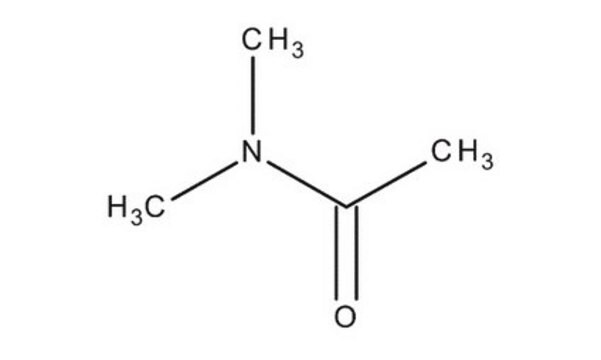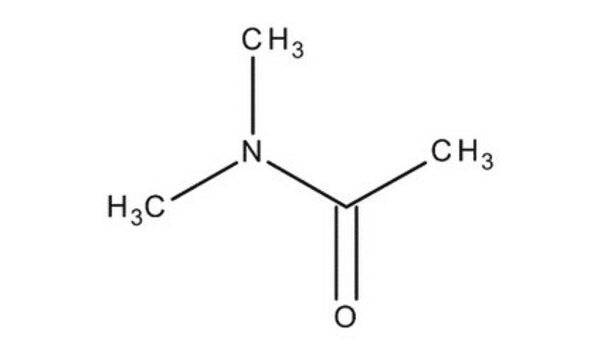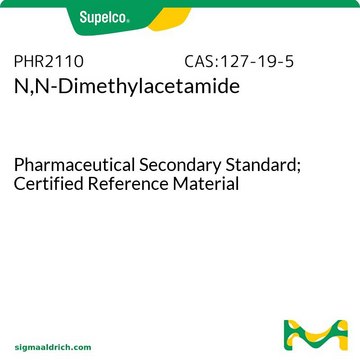270555
N,N-Dimethylacetamide
suitable for HPLC, ≥99.9%
About This Item
4 mmHg ( 38 °C)
Recommended Products
vapor density
3 (vs air)
Quality Level
vapor pressure
2 mmHg ( 25 °C)
4 mmHg ( 38 °C)
Assay
≥99.9%
form
liquid
autoignition temp.
914 °F
expl. lim.
1.8 %, 100 °F
11.5 %, 160 °F
technique(s)
HPLC: suitable
impurities
<0.030% water
evapn. residue
<0.001%
refractive index
n20/D 1.437 (lit.)
pH
4 (20 °C, 200 g/L)
bp
164.5-166 °C (lit.)
mp
−20 °C (lit.)
density
0.937 g/mL at 25 °C (lit.)
λ
H2O reference
UV absorption
λ: 270 nm Amax: 1.00
λ: 280 nm Amax: 0.30
λ: 290 nm Amax: 0.15
λ: 310 nm Amax: 0.05
λ: 320 nm Amax: 0.03
λ: 360-400 nm Amax: 0.01
application(s)
food and beverages
SMILES string
CN(C)C(C)=O
InChI
1S/C4H9NO/c1-4(6)5(2)3/h1-3H3
InChI key
FXHOOIRPVKKKFG-UHFFFAOYSA-N
Looking for similar products? Visit Product Comparison Guide
Related Categories
Application
- Ternary Phase-Field Simulation of Poly(vinylidene fluoride) Microporous Membrane Structures Prepared by Nonsolvent-Induced Phase Separation with Different Additives and Solvent Treatments: This study highlights the use of N,N-Dimethylacetamide (DMAC) in the preparation of advanced poly(vinylidene fluoride) membranes, showcasing its critical role in enhancing polymer processing and membrane structures in material science (Zhang et al., 2024).
- Improved Protein Removal Performance of PES Hollow-Fiber Ultrafiltration Membrane with Sponge-like Structure: Research demonstrates DMAC′s effectiveness in the production of high-performance ultrafiltration membranes, emphasizing its importance in biomedical applications and wastewater treatment (Zhao et al., 2024).
- Poly(vinylidene fluoride) Aerogels with alpha, beta, and gamma; Crystalline Forms: Correlating Physicochemical Properties with Polymorphic Structures: This article showcases the versatility of DMAC as a solvent in the synthesis of poly(vinylidene fluoride) aerogels, linking its use to significant advancements in the understanding of polymer crystallinity and properties (Suresh et al., 2024).
- Cellulose Esters: Synthesis for Further Formation of Films with Magnetite Nanoparticles Incorporated: The study leverages DMAC for the synthesis of advanced cellulose ester films integrated with magnetite nanoparticles, illustrating its potential in developing multifunctional materials for diverse industrial applications (Furlan Sandrini et al., 2024).
Signal Word
Danger
Hazard Statements
Precautionary Statements
Hazard Classifications
Acute Tox. 4 Dermal - Acute Tox. 4 Inhalation - Eye Irrit. 2 - Repr. 1B
Storage Class Code
6.1C - Combustible acute toxic Cat.3 / toxic compounds or compounds which causing chronic effects
WGK
WGK 2
Flash Point(F)
147.2 °F - closed cup
Flash Point(C)
64 °C - closed cup
Choose from one of the most recent versions:
Already Own This Product?
Find documentation for the products that you have recently purchased in the Document Library.
Customers Also Viewed
Our team of scientists has experience in all areas of research including Life Science, Material Science, Chemical Synthesis, Chromatography, Analytical and many others.
Contact Technical Service










